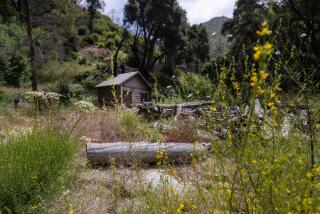Lavish Latrines, Pretty Potties
SUWON, South Korea — As the tourists crowd in for a better look, Lee Pil Ung opens one of the stalls of the ladies’ room and, speaking through a hand-held microphone, extols the virtues of the toilet.
He demonstrates the plastic wrap that revolves to supply a fresh toilet-seat cover for every user. Then, closing the door to the stall, he points to the loudspeakers piping in chamber music and to a rack of reading material that this city supplies in its public restrooms.
“This is not just a toilet,” says Lee, a volunteer tour guide who works for the city. “This is a space for culture, a space for music.”
When South Korea was selected in 1996 to co-sponsor soccer’s 2002 World Cup with Japan, officials began discussing what needed to be done to improve the infrastructure. At one session, one official embarrassed Suwon’s mayor by asking if he had ever dared to step inside the public toilet in the park downtown.
The next day, the mayor, Shim Jae Duck, visited the park restroom. He was so horrified by its squalid condition that he declared a war on filthy toilets.
The result was a $4-million toilet-improvement campaign that has succeeded beyond anybody’s wildest imagination. The public toilets have become Suwon’s claim to fame, although the city (population: 1 million) on the outskirts of Seoul also boasts an 18th century fortress and the best barbecue ribs in the South, and is one of 10 World Cup cities in the country.
Suwon might be the only city in the world (if not, certainly one of the few) that runs guided tours of its loos and has huge advertisements on its buses touting the toilets. (“Enjoy the World Heritage Fortress and Beautiful Restroom Tour,” reads the blurb on the green-and-white tour buses.)
The city also publishes a map and special guide to its toilets--which even have their own names. “The theme for this toilet complex is the harmonious joining of nature and mankind,” reads the description for a restroom called the Firefly, a name picked because, according to city officials, fireflies live only in clean environments.
The newest restrooms, not surprisingly, are in domes that look like giant soccer balls on the grounds of the World Cup stadium where the U.S. team played its first match Wednesday against Portugal.
“I had heard there were beautiful toilets in Suwon, but I didn’t believe it until I saw it with my own eyes,” said Chu Ho, a 17-year-old South Korean tourist who was photographing the soccer-ball toilets for a high school project over the weekend.
In the finest tradition of vernacular architecture, others are shaped like castles, towers and mountains, and one looks like traditional Korean pottery. Huge windows above some urinals offer panoramic views of the city. The complexes boast accoutrements rarely seen in public restrooms--bidets and child potties, among them--and touches such as music, skylights and art on the walls.
Some special features might be unfamiliar to Western tourists, such as the “etiquette bell”--when pressed, it makes a sound like running water to cover up any embarrassing sounds emanating from the stall.
Almost all of Suwon’s bathrooms have wheelchair-accessible toilets, which used to be quite a rarity in South Korea.
In fact, until recently, public toilets were a rarity. The few that existed were little more than porcelain troughs in the ground for squatting, and they were notoriously foul-smelling.
The very idea that a toilet could be something to be proud of was a novelty. The lowly position occupied by the toilet in Korean culture was typified by a popular saying: Toilets are like mothers-in-law--the farther from home, the better.
It wasn’t merely the coming of the World Cup games but the co-hosting arrangement with Japan that inspired Koreans to invest in their toilets. They worried that their infrastructure would look especially shabby next to that of their larger, richer neighbor.
“This began with an inferiority complex toward Japan,” acknowledged Shim, Suwon’s mayor. “But now Suwon is the leader in the culture of toilets. We are showing the rest of the world the toilet of the future.
“Rome or New York or Los Angeles might have clean public toilets, but we are trying to do something more. We want to make the toilet a place of culture.”
Besides building state-of-the-art public toilets, Suwon has introduced regular competitions among restaurants for the cleanest restrooms. The city occasionally has concerts at the larger public toilets.
The mayor’s high-minded ideas about toilets have spread to Seoul, where city officials also spent $4 million last year building new toilets in advance of the World Cup. The capital also sponsors an organization called Citizens Alliance for Toilet Culture, which organizes rallies in support of clean toilets and runs a Web site on public toilets.
To Shim’s immense satisfaction, he was invited to Japan last year to lecture about toilets. More kudos for Suwon’s toilets should be forthcoming this fall, when the World Toilet Organization, a group dedicated to raising public toilet standards, holds its annual convention in South Korea. (The convention itself will be 20 miles away in Seoul because of its better hotels, but Suwon will be the major excursion of the meeting.)
In Suwon, some residents complain that too much money was squandered on the toilets and that the city shouldn’t have bothered with expensive features. “The first time I saw this bidet, I didn’t even know what it was for,” schoolteacher Kim Kyun Yang said.
Chung Sung Kyu, a contractor who has been building a new mountaintop restroom with stunning views of the city, said residents shouldn’t discount the psychological boost of using such lovely bathrooms.
“It makes you happy,” he said. “The whole day will be pleasant afterward.”







